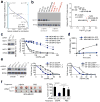MCT1-mediated transport of a toxic molecule is an effective strategy for targeting glycolytic tumors
- PMID: 23202129
- PMCID: PMC3530647
- DOI: 10.1038/ng.2471
MCT1-mediated transport of a toxic molecule is an effective strategy for targeting glycolytic tumors
Abstract
There is increasing evidence that oncogenic transformation modifies the metabolic program of cells. A common alteration is the upregulation of glycolysis, and efforts to target glycolytic enzymes for anticancer therapy are under way. Here, we performed a genome-wide haploid genetic screen to identify resistance mechanisms to 3-bromopyruvate (3-BrPA), a drug candidate that inhibits glycolysis in a poorly understood fashion. We identified the SLC16A1 gene product, MCT1, as the main determinant of 3-BrPA sensitivity. MCT1 is necessary and sufficient for 3-BrPA uptake by cancer cells. Additionally, SLC16A1 mRNA levels are the best predictor of 3-BrPA sensitivity and are most elevated in glycolytic cancer cells. Furthermore, forced MCT1 expression in 3-BrPA-resistant cancer cells sensitizes tumor xenografts to 3-BrPA treatment in vivo. Our results identify a potential biomarker for 3-BrPA sensitivity and provide proof of concept that the selectivity of cancer-expressed transporters can be exploited for delivering toxic molecules to tumors.
Figures




References
-
- Vander Heiden MG. Targeting cancer metabolism: a therapeutic window opens. Nat Rev Drug Discov. 2011;10:671–684. - PubMed
-
- Thompson CB. Rethinking the Regulation of Cellular Metabolism. Cold Spring Harb Symp Quant Biol. 2012 - PubMed
-
- Tennant DA, Duran RV, Gottlieb E. Targeting metabolic transformation for cancer therapy. Nat Rev Cancer. 2010;10:267–277. - PubMed
-
- Birsoy K, Sabatini DM, Possemato R. Untuning the tumor metabolic machine: Targeting cancer metabolism: a bedside lesson. Nat Med. 2012;18:1022–1023. - PubMed
Publication types
MeSH terms
Substances
Grants and funding
LinkOut - more resources
Full Text Sources
Other Literature Sources
Research Materials

